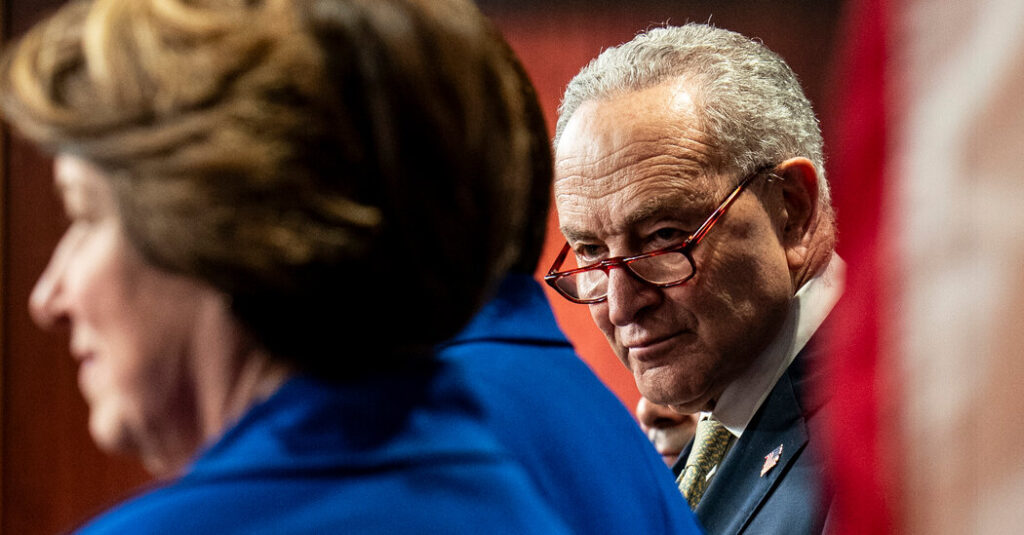The Senate plunged into a political showdown over President Trump’s domestic agenda that began Friday night and crept into Saturday morning, as Democrats forced dozens of votes during an overnight session to protest Republicans’ push to deliver “one big beautiful bill” of spending and tax cuts.
The G.O.P. needs to pass its budget blueprint to unlock a process called reconciliation, which allows lawmakers to fast-track budget legislation through Congress and shield it from a filibuster. Disagreements between Republicans in the House and the Senate about what should be in that bill had paralyzed them for weeks, but they have forged a fragile and complex compromise allowing them to move forward.
“This resolution is the first step toward a final bill to make permanent the tax relief we implemented in 2017 and deliver a transformational investment in our border, national and energy security,” said Senator John Thune of South Dakota, the majority leader.
He added later, “Let’s let the voting begin.”
But in the Senate, members can offer an array of amendments to budget measures in a ritual known as a “vote-a-rama,” a marathon of rapid-fire votes that often stretches throughout the night. The proposals will never become law, but the process allows the minority party to force a series of politically fraught votes that can be used against lawmakers in campaign advertisements later.
Democrats said they planned to spend the marathon session forcing Republicans to weigh in on a series of amendments protesting Mr. Trump’s escalating global trade war, Elon Musk’s cost-cutting Department of Government Efficiency, the G.O.P.’s proposed cuts to Medicaid and the recent use of Signal by national security officials in the Trump administration.
“Our amendments will give Republicans the chance to join us in hitting the kill switch on Donald Trump’s tariffs, on DOGE, on the attacks against Social Security and Medicare and Medicaid,” Senator Chuck Schumer of New York, the minority leader, said on Friday night minutes before voting started. “Republicans could snuff it out instantly tonight if they wanted. Will Republicans join us tonight and stand up to Donald Trump before he craters the economy?”
It was the second such all-nighter for the Senate this year, and it appeared late on Friday night that most Republicans were in little mood to lend Democrats any support — even those who have publicly expressed concerns about Mr. Trump’s tariffs and Mr. Musk’s government-slashing initiative.
Republicans rejected in a 46-to-53 party-line vote an amendment offered by Senator Mark Warner of Virginia prohibiting the use of “any commercial messaging application” to transmit information revealing the timing, sequencing or weapons to be used in impending military operations.
They defeated an amendment by Mr. Schumer to rescind Mr. Trump’s tariffs if they increased the cost of Americans’ groceries in a party-line vote. And they defeated an amendment to prevent any disruptions in continuing security assistance to Ukraine after only two Republicans — Senators Susan Collins of Maine and Lisa Murkowski of Alaska — joined Democrats to support it.
Three Republicans — Ms. Collins, Ms. Murkowski and Senator Dan Sullivan of Alaska — voted with Democrats to reverse Musk-imposed cuts to the Social Security Administration, but the vote still failed, 49 to 50.
Senators did vote 51 to 48 to adopt an amendment offered by Mr. Sullivan that amounted to a symbolic vow to protect Medicare and Medicaid.
But the budget resolution itself leaves big questions unresolved — including where Republicans plan to find the enormous spending cuts their blueprint calls for.
In February, House Republicans passed a measure that would have paved the way for one huge bill that contained $4.5 trillion in tax cuts and a $2 trillion reduction in federal spending over a decade. Senate Republicans passed their own plan that punted on the issue of taxes and spending cuts, and called for a $150 billion increase in military spending and $175 billion more for border security over the next decade.
Rather than reconcile those issues now, Republicans essentially agreed to postpone decisions on major issues, like how much they should lower spending to offset the cost of their tax cuts and where to find those reductions.
On paper, the new Senate budget outline allows for $1.5 trillion in tax cuts, a seemingly modest amount. But that figure disguises an additional $3.8 trillion for extending the 2017 tax cuts that Senate Republicans also want to include in the bill, which they argue should not show up as a cost on the federal balance sheet.
The 2017 tax cuts are scheduled to expire at the end of the year, so an extension must be included in their bill, but Republicans have said that they will steer around budget rules and declare the move cost-free. The real size of the tax cut envisioned in the Senate outline is therefore roughly $5.3 trillion over a decade, with $1.5 trillion available for new tax cuts like Mr. Trump’s proposal to not tax tips. That is far larger than the $4.5 trillion that House Republicans have given themselves.
That is just the beginning of the differences between the House and the Senate budget plans. With additional spending on defense and immigration, and minimal spending cuts, the Senate resolution could add roughly $5.7 trillion to the debt over the next 10 years. It calls for a $5 trillion increase in the debt limit, compared with the $4 trillion increase in the House plan. And House Republicans are pursuing deep spending cuts aimed at keeping the cost of their overall package to $2.8 trillion.
Some Republicans in the House have said they could be unwilling to support a Senate resolution that does not call for more fiscal restraint.
“Let’s be truthful about this; let’s worry about our debt,” said Representative Greg Murphy, Republican of North Carolina. “If we’re not going to worry about our debt, I don’t know how that works.”
Maya C. Miller contributed reporting.
https://www.nytimes.com/2025/04/04/us/politics/senate-republicans-budget-votes.html


